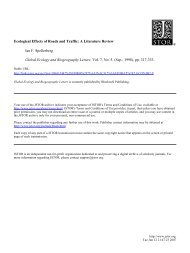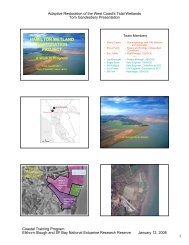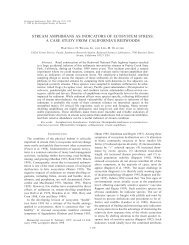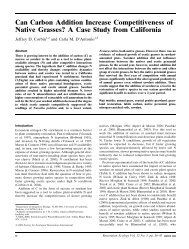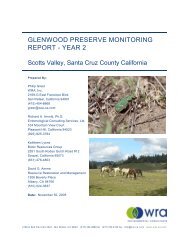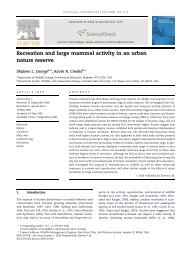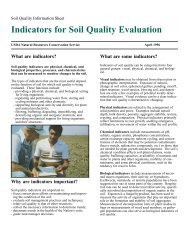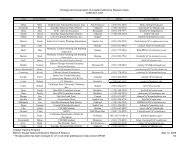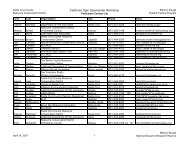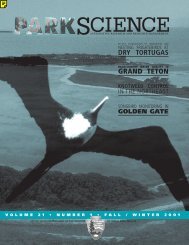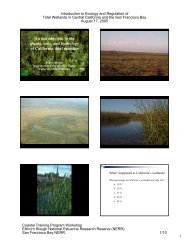DAVID J. ZIOLKOWSKI JR., KEITH L. PARDIECK AND JOHN R. SAUERthe Western, Central, and Eastern BBS regionswith 80%, 90%, and 76% of species increasing,respectively, during 2003-2008 (Fig. 1C). Surveywide,more wetland species demonstratedincrease over the long-term (58%) than not, aresult that appears to be driven by a significantand relatively high proportion of increases in theCentral region (67%). Compared to the longterm,wetland birds apparently fared well during2007-2008, with all regional percentagesexceeding, although not significantly differentfrom, 50%.Scrub/successional species, on the other hand,continued to fare poorly over the long-term anda significantly low proportion of speciesexperienced population growth across all regions(27%, Fig. 1D). The 2003-2008 time periodappeared more favorable for this guild surveywide(49%positive trends), but neither this, norany of the regional values from this period, aredistinguishable from 50%. The 29% of increaseswitnessed in the Eastern region during 2007-2008is the only regional result statisticallydistinguishable from 50%, and it is similar to thelong-term results for this region (24%).During 2003-2008, a significant number ofwoodland birds exhibited increasing trendssurvey-wide (67%), and this was greater than theproportion observed over the long-term (57%;Fig. 1E). This result appears to be driven bysignificant gains made in the Eastern regionduring 2003-2008 (74% increasing trends). The63% of species with increasing long-term trendsfrom the Central region remained nearlyunchanged and significantly high in the 2003-2008 period (64%). In contrast, the proportions ofwoodland birds with increasing trends in allregions during the 2-yr time interval, and alsothose from the Western region during the twolonger intervals, were indistinguishable from50%.Urban bird populations showed a significanttendency for decline in all regions during 1966-2008 (Fig. 1F). During that period, the 42% ofincreasing trends in the Central region balancedout the low 23% seen in the Western region,yielding a survey-wide estimate of just 33% ofurban birds increasing survey-wide. Regionalestimate from the 2003-2008 period are notdistinguishable from 50% but the continent-wideresult of 33% is significant and equivalent to the1966-2008 estimate. Each region exhibited agreater number of declines than increases duringthe 2-yr interval, although only the survey-wideresults (26% increasing trends) and Easternregion results (21% increasing trends) weresignificant.Cavity nesting birds fared relatively well withproportions of increasing species either equal toor significantly greater than 50% in all regionsand time periods (Fig 1G). For instance, 65% ofcavity nesting birds showed positive trendestimates across the entire survey area during2003-2008, including a significantly highproportion of gains in the Eastern region (75%species increasing). During 1966-2008, only theCentral region demonstrated a significantproportion of increasing species (62%).Over the long-term and across the survey,significantly more open-cup nesting speciesexperienced population declines than increases(38%; Fig. 1H). This declining pattern wasevident in Western (34% increasing trends) andEastern (30% increasing trends) BBS regions butnot in the Central region where results wereindistinguishable from 50%. A similar patternwas seen during the 2-yr interval where only25% of Western species and 31% of Easternspecies exhibited increasing trends. In contrast,during 2003-2008, only the Central regiondemonstrated a significant result with 60% ofspecies showing increasing trends.Short-distance migrants did not fare especiallywell over the long-term and only 43% of speciesexhibited positive trends survey-wide (Fig. 1I).This appears to be due in large part to thesignificantly low proportion of populationincreases in the Western and Eastern regions(34% and 30%, respectively), relative to thesignificant number of long-term increases seen inthe Central region (56%). The tendency fordecline in the West and East was similarlyreflected in the 2-yr interval, although theproportions were lower (33% and 26%,respectively), thus dropping the survey-wideestimate to 33% of species increasing during theperiod. Short-distance migrants experiencedtheir strongest increases in the Central regionduring both 1966-2008 (56% increasing trends)and 2003-2008 (63% increasing trends), althoughthe result from the later interval was notstatistically significant.During the long-term and more recent 2-yrperiods, increases in permanent residents did not[96]
NORTH AMERICAN BREEDING <strong>BIRD</strong> SURVEY 2003-2008differ significantly from 50% in any region (Fig.1J). Results from the 6-yr period were similarwith exception of the Eastern region, where asignificant number of species (68%) showedpositive population trends. Noteworthy is that,although 1966-2008 and 2003-2008 results fromthe East and West are not statistically significant,the credible intervals are relatively short andsuggest that a nearly even proportion of speciesexperienced gains and losses.Significantly fewer than 50% of neotropicalmigrant species exhibited increasing populationtrends in the Western (40%) and Eastern (34%)regions over the long-term (Fig. 1K). In contrast,neotropical migrants were significantly morelikely to experience population growth in theCentral region during that period (55% speciesincreasing). All regions surpassed thatproportion during 2003-2008 with a significantpercentage of species in both the Western andCentral regions (66%) and in the Eastern region(59%) experiencing positive trends, yielding anoverall increase of 64% positive trends surveywide.No such pattern could be discerned duringthe 2-yr period because regional results were notstatistically distinguishable from 50%.The ground nesting bird guild was amongstthe groups most likely to experience declines(Fig. 1L). Many of the long-term declines weresevere, as evidenced in the significantly lowproportion of positive trends from Western (31%)and Eastern regions (27%) and the low 29% ofincreases demonstrated survey-wide. The 2003-2008 interval portrays a more positive picturewith 46%, 60%, and 51% of ground nestersincreasing, respectively, in the Western, Central,and Eastern regions. However, no significantdeviations from 50% were detected for anyregion during this period. Declines were againapparent in the more recent 2-yr interval butonly the results from the Western region werestatistically significant, where only 20% ofspecies experienced increasing populationtrends.During 1966-2008, mid-story and canopynestingbirds fared relatively well in the CentralBBS region (63% increasing trends). Populations,however, experienced significantly fewerincreases in the Western (38%) and Eastern (42%)regions (Fig. 1M). These opposing proportionslikely account for the survey-wide result beingindistinguishable from 50%, despite having anarrow credible interval. Western and Easternregional results were equivocal and notsignificant during 2003-2008, but populations inthe Central region demonstrated a significanttendency for increase during this period (60%increasing trends). More mid-story and canopynestingbirds experienced population declinesthan increases in all BBS regions during the 2-yrinterval but these results were not significant.DISCUSSIONThe 2-yr and 6-yr trends provide generalindication of how populations fluctuated duringthese intervals. These trends show temporal andspatial heterogeneity and thus should be viewedwith caution and only interpreted within thecontext of the long-term trend results. Althoughthe majority of significant long-term trendestimates had high trend quality (Table 1), thequality of the shorter interval trend estimatesvaries considerably among regions and species.Any analysis of BBS data should carefullyconsider the possible limitations of the data andpotential trend quality issues. Additionally, theBBS is not designed to determine causal factorsof population changes. Therefore, we wereunable to identify specific factors responsible forthe various temporal and regional patternsevident in this analysis. Nevertheless, it can beinstructive to examine the overall patterns withinthe context of previous analyses to identifygeneral tendencies that could provide insight forfuture research and conservation efforts.The 2007-2008 period was relatively poor formost species across the survey, producing one ofthe lowest proportions of positive 2-yr trends(39%) ever reported in the BBS. Trends are rarelyexactly zero, so when considering combinedtrends for life-history guilds, if a group wereessentially stable, one would expect 50% ofconstituent species to have increasing trends and50% to have decreasing trends simply by chance.In 2007-2008, all groups with results deviatingsignificantly from 50% had 2/3 or more of theirconstituent species in population decline. Threeguilds (open-cup nesters, short-distancemigrants, and ground or low nesting birds)experienced greater declines in the Westernregion and 4 (successional or scrub, urban, opencupnesters, and short-distance migrants)experienced greater decline in the East. Results[97]
- Page 1 and 2:
BIRD POPULATIONSA journal of global
- Page 3 and 4:
BIRD POPULATIONSA journal of global
- Page 6 and 7:
ROBERT L. WILKERSON AND RODNEY B. S
- Page 8 and 9:
ROBERT L. WILKERSON AND RODNEY B. S
- Page 10 and 11:
ROBERT L. WILKERSON AND RODNEY B. S
- Page 12 and 13:
ROBERT L. WILKERSON AND RODNEY B. S
- Page 14 and 15:
ROBERT L. WILKERSON AND RODNEY B. S
- Page 16 and 17:
ROBERT L. WILKERSON AND RODNEY B. S
- Page 18 and 19:
ROBERT L. WILKERSON AND RODNEY B. S
- Page 20 and 21:
ROBERT L. WILKERSON AND RODNEY B. S
- Page 22 and 23:
ROBERT L. WILKERSON AND RODNEY B. S
- Page 24 and 25:
ROBERT L. WILKERSON AND RODNEY B. S
- Page 26 and 27:
ROBERT L. WILKERSON AND RODNEY B. S
- Page 28 and 29:
ROBERT L. WILKERSON AND RODNEY B. S
- Page 30 and 31:
ROBERT L. WILKERSON AND RODNEY B. S
- Page 32 and 33:
ROBERT L. WILKERSON AND RODNEY B. S
- Page 34 and 35:
ROBERT L. WILKERSON AND RODNEY B. S
- Page 36 and 37:
ROBERT L. WILKERSON AND RODNEY B. S
- Page 38 and 39:
ROBERT L. WILKERSON AND RODNEY B. S
- Page 40 and 41:
NIRANJAN DAS AND SUJATA DEORIincluy
- Page 42 and 43:
NIRANJAN DAS AND SUJATA DEORIprovid
- Page 44 and 45:
NIRANJAN DAS AND SUJATA DEORIpopula
- Page 46 and 47:
NIRANJAN DAS AND SUJATA DEORITABLE
- Page 48 and 49: NIRANJAN DAS AND SUJATA DEORITABLE
- Page 50 and 51: NIRANJAN DAS AND SUJATA DEORITABLE
- Page 52 and 53: NIRANJAN DAS AND SUJATA DEORITABLE
- Page 54 and 55: NIRANJAN DAS AND SUJATA DEORITABLE
- Page 56 and 57: NIRANJAN DAS AND SUJATA DEORITABLE
- Page 58 and 59: Bird Populations 10:56-64© The Ins
- Page 60 and 61: WETLAND BIRDS OF GHANAAvicennia afr
- Page 62 and 63: WETLAND BIRDS OF GHANATABLE 1. Data
- Page 64 and 65: WETLAND BIRDS OF GHANATABLE 2: Esti
- Page 66 and 67: WETLAND BIRDS OF GHANAATTUQUAYEFIO,
- Page 68 and 69: JANNIK HANSEN, LARS HOLST HANSEN, N
- Page 70 and 71: JANNIK HANSEN, LARS HOLST HANSEN, N
- Page 72 and 73: JANNIK HANSEN, LARS HOLST HANSEN, N
- Page 74 and 75: JANNIK HANSEN, LARS HOLST HANSEN, N
- Page 76 and 77: JANNIK HANSEN, LARS HOLST HANSEN, N
- Page 78 and 79: JANNIK HANSEN, LARS HOLST HANSEN, N
- Page 80 and 81: JANNIK HANSEN, LARS HOLST HANSEN, N
- Page 82 and 83: JANNIK HANSEN, LARS HOLST HANSEN, N
- Page 84 and 85: JANNIK HANSEN, LARS HOLST HANSEN, N
- Page 86 and 87: JANNIK HANSEN, LARS HOLST HANSEN, N
- Page 88 and 89: JANNIK HANSEN, LARS HOLST HANSEN, N
- Page 90 and 91: BIRD POPULATIONSA journal of global
- Page 92 and 93: Bird Populations 10:90-109© The In
- Page 94 and 95: DAVID J. ZIOLKOWSKI JR., KEITH L. P
- Page 96 and 97: DAVID J. ZIOLKOWSKI JR., KEITH L. P
- Page 100 and 101: DAVID J. ZIOLKOWSKI JR., KEITH L. P
- Page 102 and 103: DAVID J. ZIOLKOWSKI JR., KEITH L. P
- Page 104 and 105: DAVID J. ZIOLKOWSKI JR., KEITH L. P
- Page 106 and 107: DAVID J. ZIOLKOWSKI JR., KEITH L. P
- Page 108 and 109: DAVID J. ZIOLKOWSKI JR., KEITH L. P
- Page 110 and 111: DAVID J. ZIOLKOWSKI JR., KEITH L. P
- Page 112 and 113: Bird Populations 10:110-113© The I
- Page 114 and 115: THE 2007 AND 2008 NORTH AMERICAN BR
- Page 116 and 117: Bird Populations 10:114-124© The I
- Page 118 and 119: BREEDING BIRD CENSUS: 2007on the pl
- Page 120 and 121: BREEDING BIRD CENSUS: 2007May, with
- Page 122 and 123: BREEDING BIRD CENSUS: 2007Remarks:
- Page 124 and 125: BREEDING BIRD CENSUS: 200717. PITCH
- Page 126 and 127: BREEDING BIRD CENSUS: 2007+; Wester
- Page 128 and 129: BREEDING BIRD CENSUS: 2008gray Gnat
- Page 130 and 131: BREEDING BIRD CENSUS: 2008Warbler,
- Page 132 and 133: BREEDING BIRD CENSUS: 2008Source: W
- Page 134 and 135: BREEDING BIRD CENSUS: 2008Spotted T
- Page 136 and 137: BREEDING BIRD CENSUS: 2008precipita
- Page 138 and 139: Bird Populations 10© The Institute
- Page 140 and 141: IS AVIAN BREEDING SUCCESS WEATHERIN
- Page 142 and 143: IS AVIAN BREEDING SUCCESS WEATHERIN
- Page 144 and 145: DAVE LEECH AND CARL BARIMOREFlycatc
- Page 146 and 147: Bird Populations 10:143-145Reprinte
- Page 148 and 149:
WOODPIGEON JOINS THE GARDEN PREMIER
- Page 150 and 151:
CHANGING THE GUARD AT UK BIRDTABLES
- Page 152 and 153:
Bird Populations is an entirely ele
- Page 154:
BIRD POPULATIONSA journal of global



